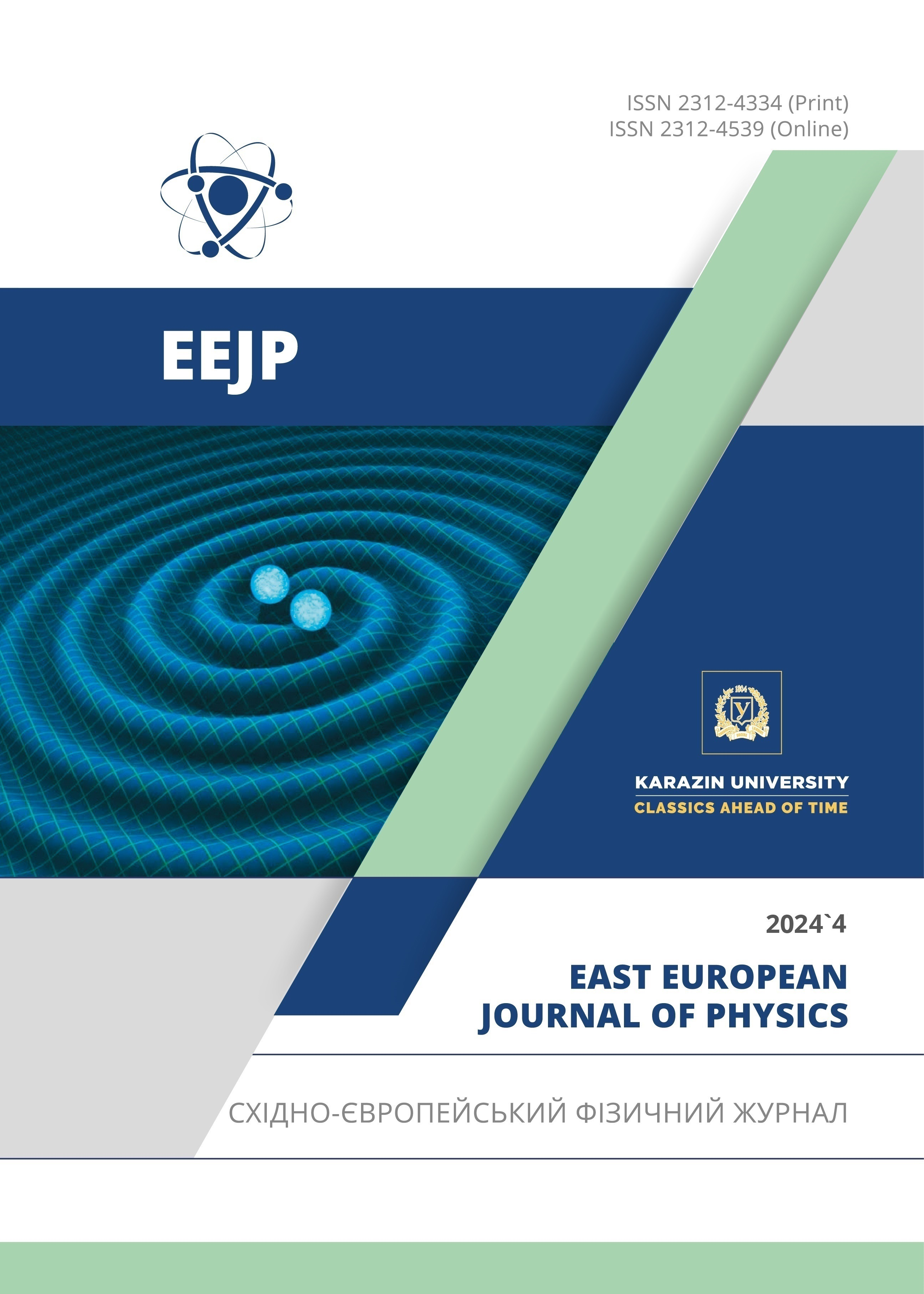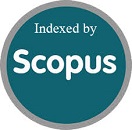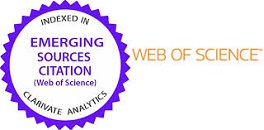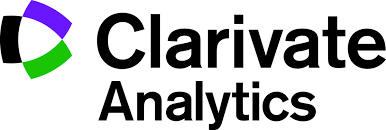Energy of Crystal Lattice Thermal Oscillations in TlGaS2 Semiconductor Compound
Abstract
This article presents the results of a study of the temperature dependences of the coefficients of thermal expansion and isothermal compressibility of the ternary compound TlGaS2. In the studied temperature range (80-400 K), no anomalies were found in the temperature dependences of these properties. The thermal expansion coefficient of the TlGaS2 semiconductor compound is calculated based on empirical formulas including Debye temperature and Debye functions, and the average energy of the crystal lattice is calculated and its temperature dependence is tabulated. It was shown that the energy of the crystal lattice depends on the degree of anharmonicity of the oscillations.
Downloads
References
M. Isik, A. Karatay, and N.M. Gasanly, “Structural and optical characteristics of thermally evaporated TlGaSe2 thin films,” Optical Materials, 124, 112018 (2022). https://doi.org/10.1016/j.optmat.2022.112018
W. Henkel, H.D. Hochheimer, C. Carlone, A. Werner, S. Ves, and H.G. Schnering, “High-pressure Raman study of the ternary chalcogenides TlGaS2, TlGaSe2, TlInS2 and TlInSe2,” Phys. Rev. B, 26(6), 3211–3221 (1982). https://doi.org/10.1103/PhysRevB.26.3211
G.E. Delgadoa, A.J. Mora, F.V. Perez, and J. Gonzalez, “Crystal structure of the ternary semiconductor compound thallium gallium sulfide, TlGaS2,” Physica B: Condens. Matter. 391(2), 385–388 (2007). https://doi.org/10.1016/j.physb.2006.10.030
D.I.Huseynov, M.I.Murguzov, Sh.S.Ismailov Thermal conductivity of ErxSn1-xSe (x ≤ 0.025) solid solutions,” Inorganic Materials, 44, 467–469 (2008). https://doi.org/10.1134/S0020168508050063
X. Xin, F. Liu, X.-Q. Yan, W. Hui, X. Zhao, X. Gao, Z.-B. Liu, and J.-G.Tian, “Two-photon absorption and non-resonant electronic nonlinearities of layered semiconductor TlGaS2,” Opt Express, 26(26), 33895 33905 (2018). https://doi.org/10.1364/OE.26.033895
Y. Fu, D. He, J. He, X. Han, J. Bai, Y. Wang, and H. Zhao, “Photocarrier dynamics in TlGaS2 nanoflakes and van der waals heterostructures with hexagonal boron nitride and WS2 nanoflakes: implications for optoelectronic applications,” ACS Applied Nano Materials, 3, 8702–8707 (2020). https://doi.org/10.1021/acsanm.0c01448
B.A. Ünlü, A. Karatay, E.A. Yildiz, T. Dinçbay, H. Ünver, N. Gasanly, and A. Elmali, “Defect assisted nonlinear absorption and optical limiting in amorphous 〖TlGaS〗_(2(1-x)) 〖Se〗_2x (0≤x≤1)thin films,” Journal of Luminescence, 241, 118540 (2022). https://doi.org/10.1016/j.jlumin.2021.118540
S.Delice, M.Isik, N.M. asanly, Thermoluminescence properties and trapping parameters of TlGaS 2 single crystals // Journal of Luminesce, 2022, 244, 118714, https://doi.org/10.1016/j.jlumin.2021.118714
A. Say, D. Adamenko, O. Gomonnai, I. Roman, I. Martynyuk-Lototska, and R. Vlokh, “Anisotropy of thermal expansion of TlGaSe_2 crystals,” Phase Transitions, 92(9), 824-830 (2019). https://doi.org/10.1080/01411594.2019.1642475
I. Martynyuk-Lototska, O. Mys, A. Say, et al., “Anisotropy of acoustic and thermal expansion properties of TlInSe2 crystals,” Phase Transitions, 92(1), 23–35 (2019). https://doi.org/10.1080/01411594.2018.1545227
B. Gurkan, and S. Berber, “Structural and electronic properties of layered semiconductor chalcogenide crystals: TIGaSe2, TIGaS2 and TIInS2,” J. Indian Chem. Soc. 96, 1123-1130 (2019). https://doi.org/10.5281/zenodo.5643212
M. Isik, A. Karatay, A.N. Ech-Chergui, and N.M. Gasanly, “Study of the structural and optical properties of thallium gallium disulfide (TlGaS2) thin films grown via thermal evaporation,” Physica Scripta, 97(7), 075808 (2022). https://doi.org/10.1088/1402-4896/ac74f0
Z. Cicek, S. Yakut, D. Deger, D. Bozoglu, S. Mustafaeva, P. Ismailova, A.A. Hasanov, and K. Ulutas, “Thickness dependence of dielectric properties of〖TlGaS〗_2 thin films,” Materials Science in Semiconductor Processing, 166, 107733 (2023). https://doi.org/10.1016/j.mssp.2023.107733
Y.S. Touloukian, R.K. Kirby, R.E. Taylor, and T.Y.R. Lee, Thermal Expansion: Nonmetallic Solids (Thermophysical properties of matter, vol. 13, (IFI/Plenum, New York, 1977).
M.S. Barabashko, A.I. Krivchikov, R. Basnukaeva, O.A. Korolyuk, and A. Jeżowsk, “Proportional correlation between heat capacity and thermal expansion of atomic, molecular crystals and carbon nanostructures,” Condensed Matter Physics, 26(3), 33602 (2023). https://doi.org/10.5488/CMP.26.33602
C. Kittel, Introduction to Solid State Physics, 8th ed. (John Wiley & Sons: New York, USA, 2005).
B.M. Askerov, and S.R. Figarova, Thermodynamics, Gibbs Method and Statistical Physics of Electron Gases, (Springer-Verlag, Berlin, Heidelberg, 2010).
M.T. Cao-Rial, C. Moreno, and P. Quintela, “Determination of Young modulus by using Rayleigh waves,” Applied Mathematical Modelling, 77, Part 1, 439-455 (2020). https://doi.org/10.1016/j.apm.2019.07.051
O.L. Anderson, “A simplified method for calculating the Debye temperature from elastic constants,” Journal of Physics and Chemistry of Solids, 24(7), 909-917 (1963). https://doi.org/10.1016/0022-3697(63)90067-2
D.C. Wallace, Thermodynamics of crystals, (Dover Publications, Wiley, New York, 1998).
O. Madelung, Introduction to Solid-State Theory, (Springer Science & Business Media, 1996).
Copyright (c) 2024 Kamala М. Guseinova, Fuad A. Mammadov, Aynure A. Hadiyeva, Vusala I. Eminova, Cahangir I. Huseynov

This work is licensed under a Creative Commons Attribution 4.0 International License.
Authors who publish with this journal agree to the following terms:
- Authors retain copyright and grant the journal right of first publication with the work simultaneously licensed under a Creative Commons Attribution License that allows others to share the work with an acknowledgment of the work's authorship and initial publication in this journal.
- Authors are able to enter into separate, additional contractual arrangements for the non-exclusive distribution of the journal's published version of the work (e.g., post it to an institutional repository or publish it in a book), with an acknowledgment of its initial publication in this journal.
- Authors are permitted and encouraged to post their work online (e.g., in institutional repositories or on their website) prior to and during the submission process, as it can lead to productive exchanges, as well as earlier and greater citation of published work (See The Effect of Open Access).








